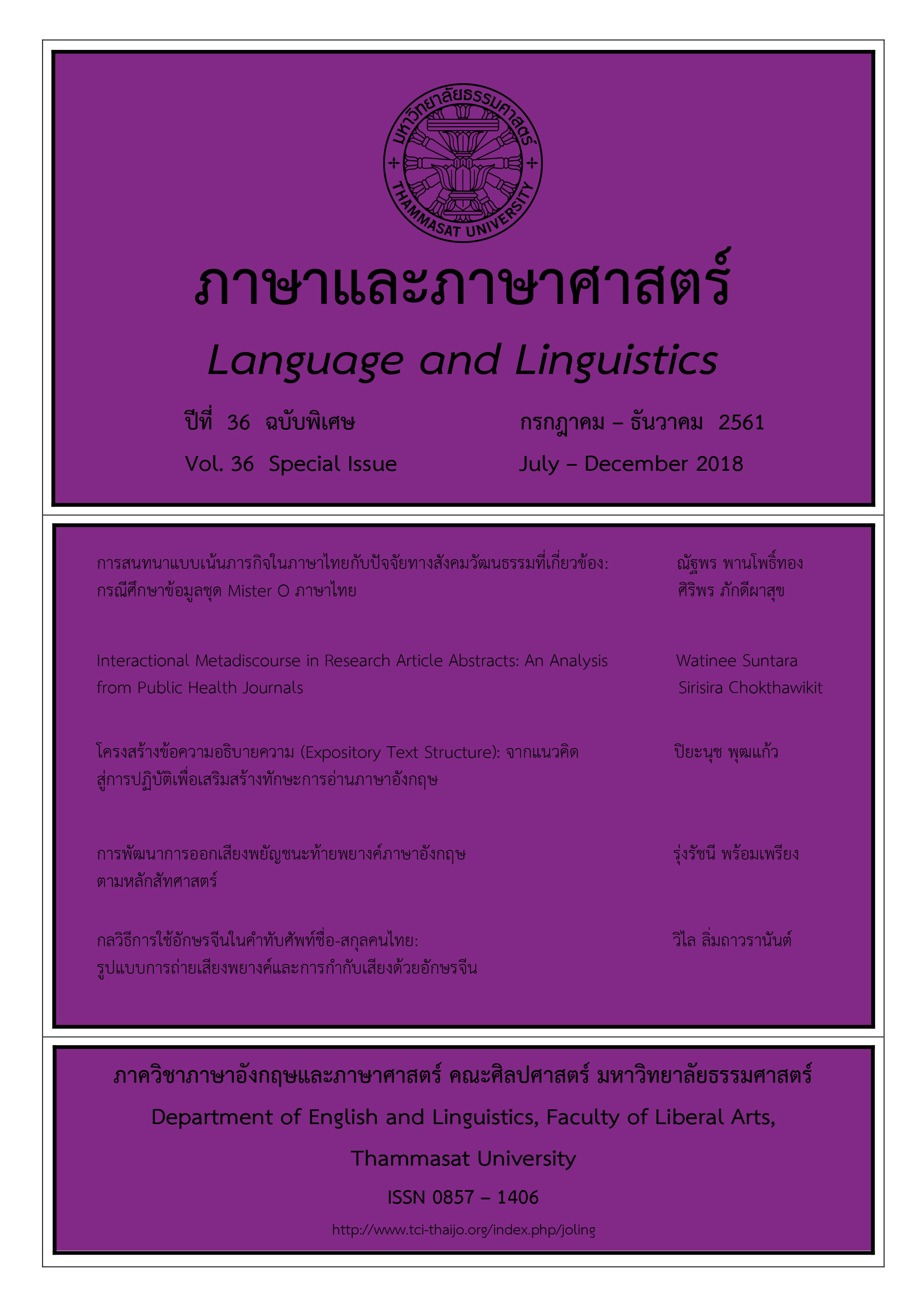Interactional Metadiscourse in Research Article Abstracts: An Analysis from Public Health Journals
Main Article Content
Abstract
Research article (RA) abstracts are the first point of contact for readers of academic works seeking research in their fields. They also determine whether readers decide to read the rest of the article. For these reasons, skillfully written RA abstracts are important for novice writers who wish to enter the discourse community of their discipline. Previous studies, e.g., Chang (2016) Gillaerts and van de Velde (2010) Liu and Huang (2017) have taken a closer look by exploring interactional and interactive metadiscourse markers in RA abstracts. Key findings show that RA abstracts are likely to be persuasive endeavors with interaction between authors and readers. Although many disciplines have been subjected to this rhetorical analysis, very few studies have explored interactional and interactive metadiscourse markers in the discipline of public health. The present study addresses this gap by analyzing interactional and interactive metadiscourse markers in 60 RA abstracts within the discipline of public health. Based on Hyland (2005b) classification of stance and taxonomy of interactive metadiscourse markers (Hyland, 2005a), the findings revealed that the most frequent uses of stance were attitude markers, self-mentions, hedges and boosters, respectively. Moreover, the use of transition markers to project additive, consequential or contrastive connections were found extensively. Our findings suggest that RA abstracts are a persuasive endeavor reflecting social communication and an interaction between author and audience.
Article Details
บทความทุกบทความเป็นลิขสิทธิ์ของภาษาและภาษาศาสตร์
References
affect. Text, 9(1), 93–124.
Biber, D. (2006). Stance in spoken and written university registers. Journal of English for Academic Purposes, 5(2),
97-116.
Chang, P. (2016). An exploration of interactional metadiscourse in architecture research articles. Proceedings of
The Joint International Conference of the 8th International Conference on ESP in Asia & the 3rd International
Symposium on Innovative Teaching and Research in ESP, 5-12.
Clarivate Analytics. (2017) InCites Journal Citation Reports. Retrieved from
https://jcr.incites.thomsonreuters.com/JCRLandingPageAction.action?Init=Yes&SrcApp=IC2LS&SID=H2AJqOr5jhmXgWCNJiKIypQwHa7Vl5fiw118x2dOW02WNHqyGUPrQKQ8eH2vwx3Dx3Dsj6veFHR8AMkV8eo
xxlKo5Qx3Dx3D-YwBaX6hN5JZpnPCj2lZNMAx3Dx3D-jywguyb6iMRLFJm7wHskHQx3Dx3D
Crismore, A. (1989). Talking with readers: Metadiscourse as rhetorical act. New York: Peter Lang.
Gillaerts, P., & van de Velde, F. (2010). Interactional metadiscourse in research article abstracts. Journal of English
for Academic Purposes, 9(2), 128-139.
Halliday, M.A.K. (1994). An introduction to functional grammar (2nd ed). London: Edward Arnold.
Hu, G. W., & Cao, F. (2011). Hedging and boosting in abstracts of applied linguistics articles: A comparative study
of English- and Chinese-medium journals. Journal of Pragmatics, 43(1), 2795-2809.
Hunston, S., & Thompson, G. (2000). Evaluation in text: Authorial stance and the construction of discourse.
Oxford: Oxford University Press.
Hyland, K. (1998a). Hedging in scientific research articles. Amsterdam: John Benjamins.
______. (1998b). Persuasion and context: The pragmatics of academic metadiscourse. Journal of Pragmatics,
30(4), 437-455.
______. (1999). Disciplinary discourses: Writer stance in research articles. In C. Candlin and K. Hyland (Eds.).
Writing: Texts: Processes and Practices. London: Longman.
______. (2000). Disciplinary discourse: Social interactions in academic writing. London: Longman.
______. (2002). Directives: Argument and Engagement in Academic Writing. Applied Linguistics, 23(2), 215-239.
______. (2005a). Metadiscourse: Exploring writing in interaction. London: Continuum.
______. (2005b). Stance and engagement: A model of interaction in academic discourse. Discourse Studies, 7(2),
173-192.
Hyland, K., & Tse, P. (2004). Metadiscourse in academic writing: A reappraisal. Applied Linguistics, 25(2),
156-177.
Jaffe, A. (2009). Stance: Sociolinguistics perspectives. Oxford Scholarship Online, 1-34. Retrieved from
https://web.stanford.edu/~eckert/PDF/kiesling2009.pdf
Khedri, M., Heng, C., & Ebrahimi, S. (2013). An exploration of interactive metadiscourse markers in academic
research article abstracts in two disciplines. Discourse Studies, 15(3), 319-331.
Liu, P., & Huang, X. (2017). A study of interactional metadiscourse in English abstracts of Chinese economics
research articles. Higher Education Studies, 7(3), 25-41.
Martin, J. (2000). Beyond exchange: APPRAISAL systems in English, in S. Hunston & G.Thompson (Eds.)
Evaluation in Text. Oxford: Oxford University Press.
Nwogu, K. N. (1991). Structure of science popularizations: A genre-analysis approach to the schema of
popularized medical texts. English for Specific Purposes, 10(2), 111-123.
Pho, P. D. (2008). Research article abstracts in applied linguistics and educational technology: A study of
linguistic realizations of rhetorical structure and authorial stance. Discourse Studies, 10(2), 231-250.
Stotesbury, H. (2003). Evolution in research article abstracts in the narrative and hard sciences. Journal of English
for Academic Purposes, 2(4), 327-341.
Suntara, W., & Usaha, S. (2013). Research article abstracts in two related disciplines: Rhetorical variation
between linguistics and applied linguistics. English Language Teaching, 6(2), 84-99.
Swales, J. M. (1990). Genre analysis: English in academic and research settings. New York: Cambridge University
Press.
Ventola, E. (1994) Abstracts as an Object of Linguistic Study, In S. Cmejrkova, F. Danes, & E. Havlova (eds.)
Writing vs Speaking: Language, Text, Discourse, Communication. Proceedings of the Conference held at the
Czech Language Institute of the Academy of Sciences of the Czech Republic (pp. 333-52). Tubingen:
G. Narr.
White, P. (2003). Beyond modality and hedging: A dialogic view of the language of intersubjective stance. Text,
23(2), 259–284.


